Abstract
It has been postulated that low density lipoprotein (LDL) becomes fully atherogenic only if it first undergoes oxidative modification. The oxidatively modified form, but not native LDL, is recognized by the acetyl-LDL or "scavenger" receptor and could, therefore, be taken up rapidly by tissue macrophages to generate the fatty-streak lesion of atherosclerosis. However, there is thus far very little direct evidence for oxidative modification in vivo. The studies reported here take advantage of the fact that probucol is an effective antioxidant transported in lipoproteins, including LDL, and blocks the oxidative modification of LDL in vitro. We now show that the rate of degradation of LDL in the macrophage-rich fatty-streak lesions of the LDL receptor-deficient rabbit treated with probucol (1% by weight in the diet) is reduced to about one-half of that in the lesions of receptor-deficient rabbits not given probucol (but matched for plasma cholesterol levels). In contrast, the rates of degradation in the nonlesioned areas of the aorta were no different in probucol-treated and control animals. Most of the LDL degradation in fatty-streak lesions takes place in macrophages, whereas in nonlesioned aorta, which contains very few macrophages, the degradation is almost exclusively in endothelial cells and smooth muscle cells. Thus, the results are compatible with the postulate that the native LDL taken up and degraded by foam cells in the developing fatty-streak lesions was in part first converted to a form recognized by the scavenger receptor (by oxidative or analogous modification). Finally, and most importantly, we show that treatment with probucol significantly reduced the rate of development of fatty-streak lesions even though plasma cholesterol levels were no lower than lovastatin-treated (control) rabbits.
Full text
PDF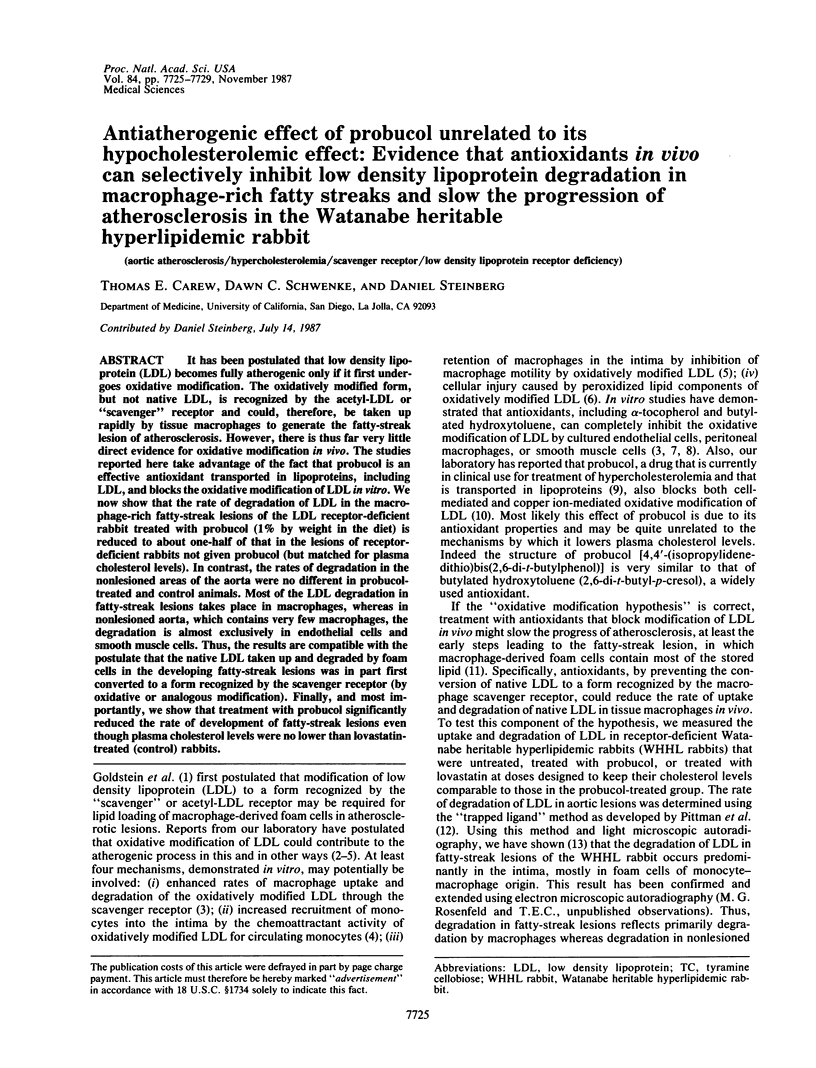
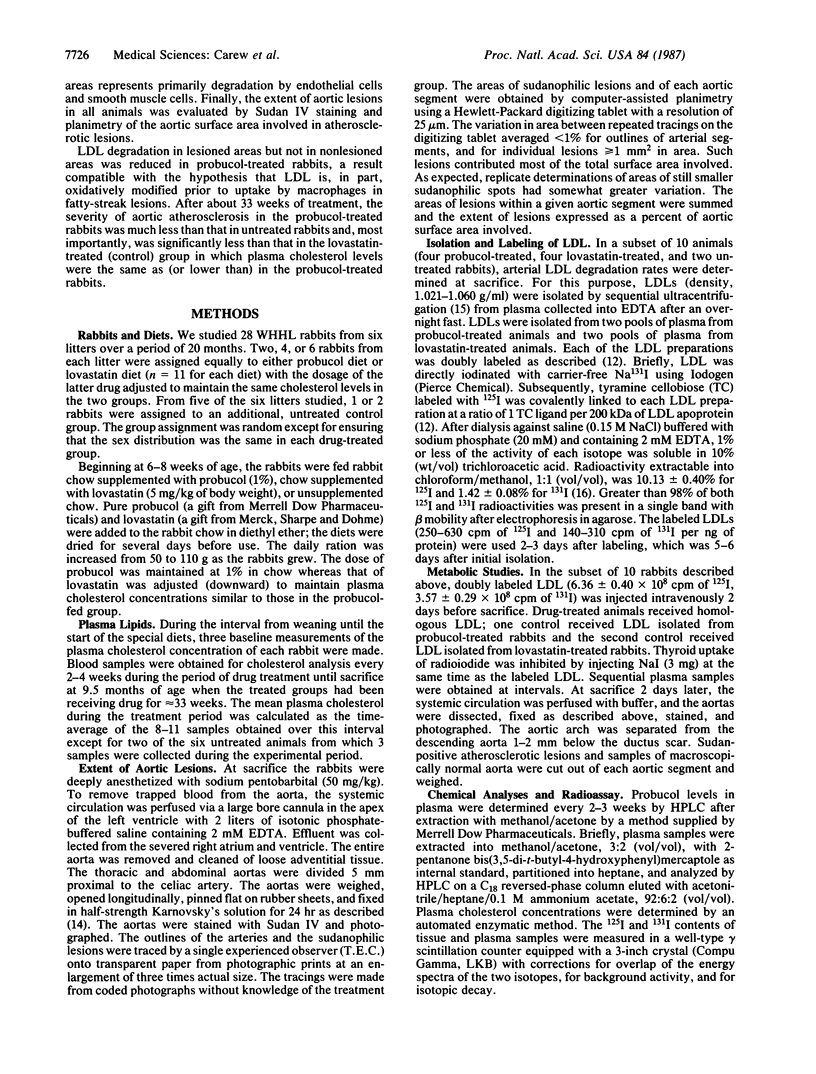
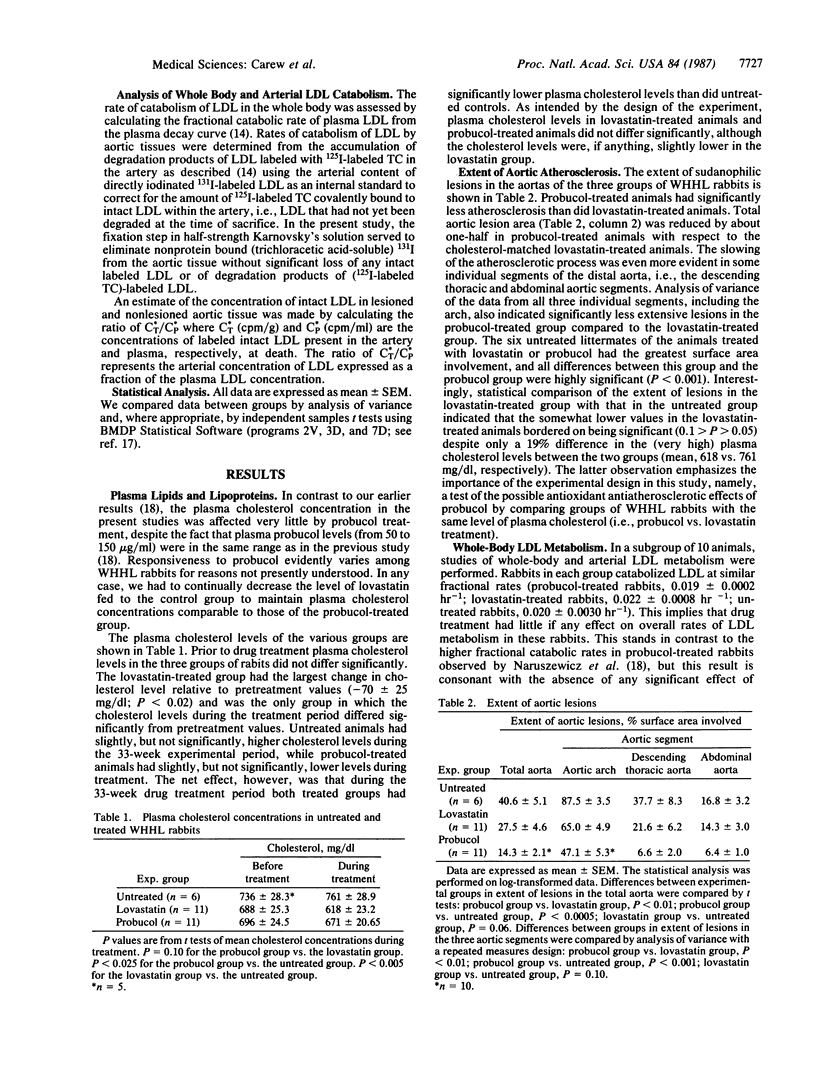
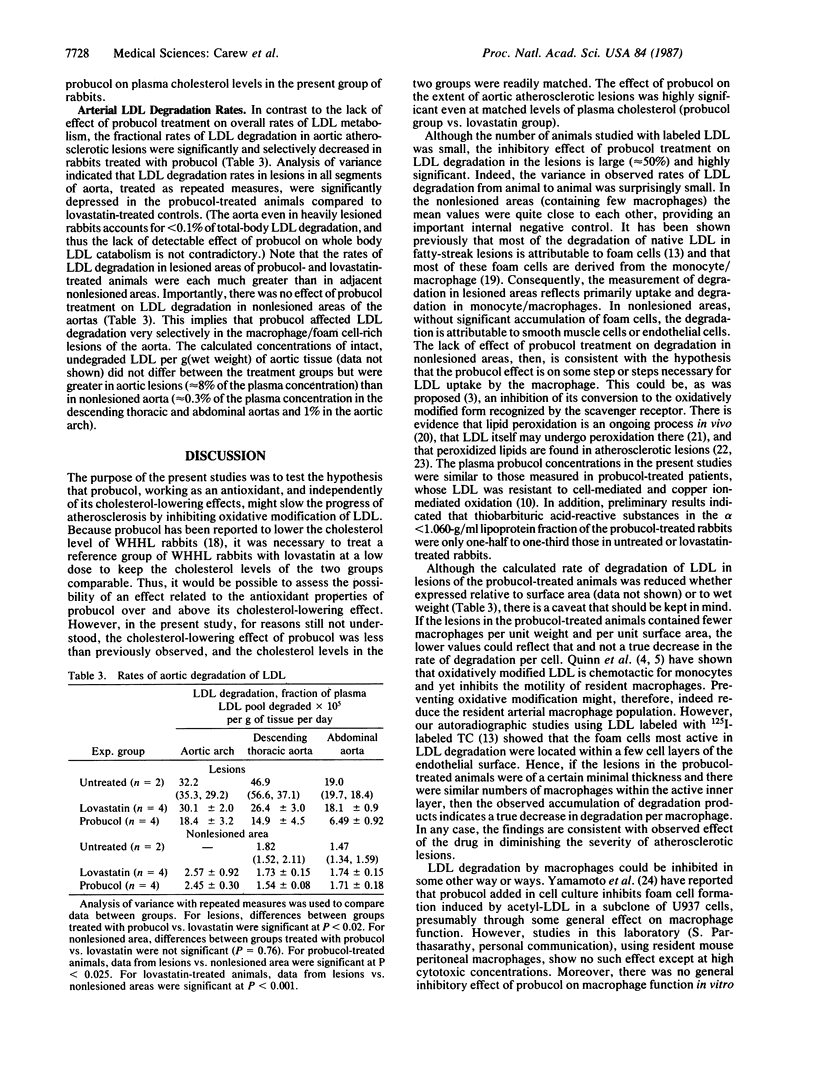
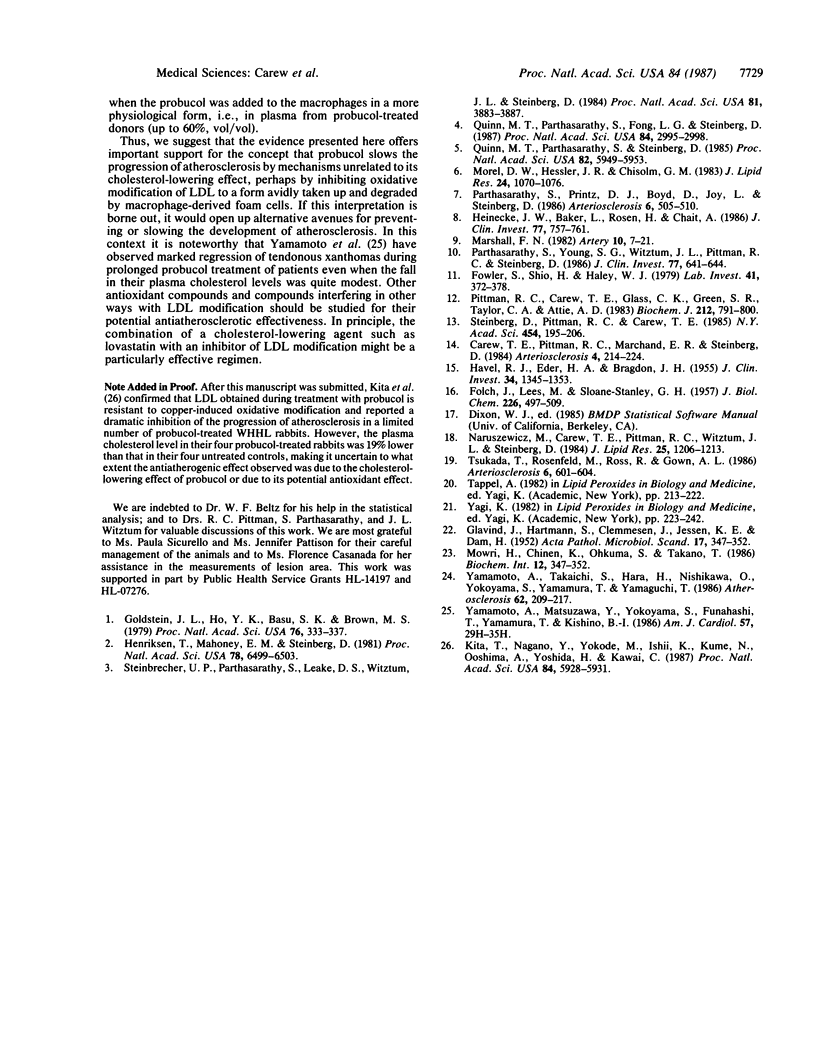
Selected References
These references are in PubMed. This may not be the complete list of references from this article.
- Carew T. E., Pittman R. C., Marchand E. R., Steinberg D. Measurement in vivo of irreversible degradation of low density lipoprotein in the rabbit aorta. Predominance of intimal degradation. Arteriosclerosis. 1984 May-Jun;4(3):214–224. doi: 10.1161/01.atv.4.3.214. [DOI] [PubMed] [Google Scholar]
- FOLCH J., LEES M., SLOANE STANLEY G. H. A simple method for the isolation and purification of total lipides from animal tissues. J Biol Chem. 1957 May;226(1):497–509. [PubMed] [Google Scholar]
- Fowler S., Shio H., Haley N. J. Characterization of lipid-laden aortic cells from cholesterol-fed rabbits. IV. Investigation of macrophage-like properties of aortic cell populations. Lab Invest. 1979 Oct;41(4):372–378. [PubMed] [Google Scholar]
- Goldstein J. L., Ho Y. K., Basu S. K., Brown M. S. Binding site on macrophages that mediates uptake and degradation of acetylated low density lipoprotein, producing massive cholesterol deposition. Proc Natl Acad Sci U S A. 1979 Jan;76(1):333–337. doi: 10.1073/pnas.76.1.333. [DOI] [PMC free article] [PubMed] [Google Scholar]
- HAVEL R. J., EDER H. A., BRAGDON J. H. The distribution and chemical composition of ultracentrifugally separated lipoproteins in human serum. J Clin Invest. 1955 Sep;34(9):1345–1353. doi: 10.1172/JCI103182. [DOI] [PMC free article] [PubMed] [Google Scholar]
- Heinecke J. W., Baker L., Rosen H., Chait A. Superoxide-mediated modification of low density lipoprotein by arterial smooth muscle cells. J Clin Invest. 1986 Mar;77(3):757–761. doi: 10.1172/JCI112371. [DOI] [PMC free article] [PubMed] [Google Scholar]
- Henriksen T., Mahoney E. M., Steinberg D. Enhanced macrophage degradation of low density lipoprotein previously incubated with cultured endothelial cells: recognition by receptors for acetylated low density lipoproteins. Proc Natl Acad Sci U S A. 1981 Oct;78(10):6499–6503. doi: 10.1073/pnas.78.10.6499. [DOI] [PMC free article] [PubMed] [Google Scholar]
- Kita T., Nagano Y., Yokode M., Ishii K., Kume N., Ooshima A., Yoshida H., Kawai C. Probucol prevents the progression of atherosclerosis in Watanabe heritable hyperlipidemic rabbit, an animal model for familial hypercholesterolemia. Proc Natl Acad Sci U S A. 1987 Aug;84(16):5928–5931. doi: 10.1073/pnas.84.16.5928. [DOI] [PMC free article] [PubMed] [Google Scholar]
- Marshall F. N. Pharmacology and toxicology of probucol. Artery. 1982;10(1):7–21. [PubMed] [Google Scholar]
- Morel D. W., Hessler J. R., Chisolm G. M. Low density lipoprotein cytotoxicity induced by free radical peroxidation of lipid. J Lipid Res. 1983 Aug;24(8):1070–1076. [PubMed] [Google Scholar]
- Mowri H., Chinen K., Ohkuma S., Takano T. Peroxidized lipids isolated by HPLC from atherosclerotic aorta. Biochem Int. 1986 Feb;12(2):347–352. [PubMed] [Google Scholar]
- Naruszewicz M., Carew T. E., Pittman R. C., Witztum J. L., Steinberg D. A novel mechanism by which probucol lowers low density lipoprotein levels demonstrated in the LDL receptor-deficient rabbit. J Lipid Res. 1984 Nov;25(11):1206–1213. [PubMed] [Google Scholar]
- Parthasarathy S., Printz D. J., Boyd D., Joy L., Steinberg D. Macrophage oxidation of low density lipoprotein generates a modified form recognized by the scavenger receptor. Arteriosclerosis. 1986 Sep-Oct;6(5):505–510. doi: 10.1161/01.atv.6.5.505. [DOI] [PubMed] [Google Scholar]
- Parthasarathy S., Young S. G., Witztum J. L., Pittman R. C., Steinberg D. Probucol inhibits oxidative modification of low density lipoprotein. J Clin Invest. 1986 Feb;77(2):641–644. doi: 10.1172/JCI112349. [DOI] [PMC free article] [PubMed] [Google Scholar]
- Pittman R. C., Carew T. E., Glass C. K., Green S. R., Taylor C. A., Jr, Attie A. D. A radioiodinated, intracellularly trapped ligand for determining the sites of plasma protein degradation in vivo. Biochem J. 1983 Jun 15;212(3):791–800. doi: 10.1042/bj2120791. [DOI] [PMC free article] [PubMed] [Google Scholar]
- Quinn M. T., Parthasarathy S., Fong L. G., Steinberg D. Oxidatively modified low density lipoproteins: a potential role in recruitment and retention of monocyte/macrophages during atherogenesis. Proc Natl Acad Sci U S A. 1987 May;84(9):2995–2998. doi: 10.1073/pnas.84.9.2995. [DOI] [PMC free article] [PubMed] [Google Scholar]
- Quinn M. T., Parthasarathy S., Steinberg D. Endothelial cell-derived chemotactic activity for mouse peritoneal macrophages and the effects of modified forms of low density lipoprotein. Proc Natl Acad Sci U S A. 1985 Sep;82(17):5949–5953. doi: 10.1073/pnas.82.17.5949. [DOI] [PMC free article] [PubMed] [Google Scholar]
- Steinberg D., Pittman R. C., Carew T. E. Mechanisms involved in the uptake and degradation of low density lipoprotein by the artery wall in vivo. Ann N Y Acad Sci. 1985;454:195–206. doi: 10.1111/j.1749-6632.1985.tb11858.x. [DOI] [PubMed] [Google Scholar]
- Steinbrecher U. P., Parthasarathy S., Leake D. S., Witztum J. L., Steinberg D. Modification of low density lipoprotein by endothelial cells involves lipid peroxidation and degradation of low density lipoprotein phospholipids. Proc Natl Acad Sci U S A. 1984 Jun;81(12):3883–3887. doi: 10.1073/pnas.81.12.3883. [DOI] [PMC free article] [PubMed] [Google Scholar]
- Tsukada T., Rosenfeld M., Ross R., Gown A. M. Immunocytochemical analysis of cellular components in atherosclerotic lesions. Use of monoclonal antibodies with the Watanabe and fat-fed rabbit. Arteriosclerosis. 1986 Nov-Dec;6(6):601–613. doi: 10.1161/01.atv.6.6.601. [DOI] [PubMed] [Google Scholar]
- Yamamoto A., Matsuzawa Y., Yokoyama S., Funahashi T., Yamamura T., Kishino B. Effects of probucol on xanthomata regression in familial hypercholesterolemia. Am J Cardiol. 1986 Jun 27;57(16):29H–35H. doi: 10.1016/0002-9149(86)90434-0. [DOI] [PubMed] [Google Scholar]
- Yamamoto A., Takaichi S., Hara H., Nishikawa O., Yokoyama S., Yamamura T., Yamaguchi T. Probucol prevents lipid storage in macrophages. Atherosclerosis. 1986 Dec;62(3):209–217. doi: 10.1016/0021-9150(86)90095-x. [DOI] [PubMed] [Google Scholar]


